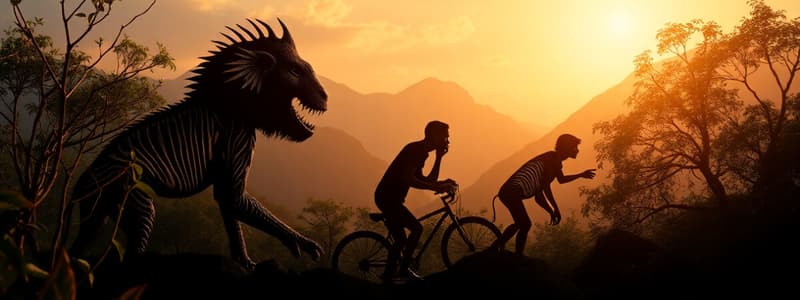Podcast
Questions and Answers
What is scientific thinking and how does it work?
What is scientific thinking and how does it work?
Scientific thinking is a structured way of finding information on observable events in nature. It works through making observations, formulating hypotheses, making predictions, and conducting experiments.
How does a hypothesis differ from a theory or a prediction?
How does a hypothesis differ from a theory or a prediction?
A hypothesis is a suggested prediction of a possible correlation among two things. A theory is a tested, proven explanation for a set of factors, and predictions can lead to hypotheses and potentially theories through testing.
What does it mean to control an experiment?
What does it mean to control an experiment?
Controlling an experiment means to manage all variables in a study ensuring only the independent variable is changed while all other factors are kept constant.
Compare and contrast superstitions, anecdotal observations, and pseudoscience.
Compare and contrast superstitions, anecdotal observations, and pseudoscience.
With more and more observations that support a hypothesis, can you eventually say it is true?
With more and more observations that support a hypothesis, can you eventually say it is true?
What is evolution and how does it occur? (Name the four ways and give an example)
What is evolution and how does it occur? (Name the four ways and give an example)
What is natural selection?
What is natural selection?
What ideas and observations influenced Darwin?
What ideas and observations influenced Darwin?
Why does artificial selection almost always work?
Why does artificial selection almost always work?
How is genetic drift related to Mendel’s first law?
How is genetic drift related to Mendel’s first law?
What is sexual selection and why does it lead to trade-offs? Include an example.
What is sexual selection and why does it lead to trade-offs? Include an example.
What is the norm of reaction and how does the slope describe the relation between genotype and phenotype?
What is the norm of reaction and how does the slope describe the relation between genotype and phenotype?
Flashcards are hidden until you start studying
Study Notes
Scientific Thinking
- Scientific thinking is a structured process for understanding observable natural events. It involves making observations, formulating hypotheses, making predictions, and conducting experiments.
- A hypothesis is a suggested explanation for a possible correlation between factors, while a theory is a tested and proven explanation for a set of phenomena.
- Controlling an experiment involves managing all variables, ensuring only the independent variable is altered to isolate the effect of that variable.
- Superstitions, anecdotal observations, and pseudoscience are all examples of unscientific thinking.
- Supporting evidence strengthens a hypothesis, but it can never be completely proven true as knowledge evolves.
Evolution and Natural Selection
- Evolution occurs through changes in allele frequency within a population. This can happen through genetic drift, natural selection, mutation, and gene flow.
- Natural selection favors traits that increase an organism's survival and reproduction in their specific environments. This requires variability in traits, heritability of those traits, and differential reproductive success.
- Darwin's observations of finches on the Galapagos Islands, similarities between fossils and living species, offspring overproduction, competition for resources, and the inheritance of traits influenced his theory of evolution.
- Artificial selection works similarly to natural selection because it involves choosing organisms with specific traits to breed, ensuring those traits are passed down, even if the trait selection is determined by humans rather than nature.
- Genetic drift is related to Mendel's first law as both involve the random distribution of alleles within a population.
- Sexual selection, a type of evolution, favors traits that increase reproductive success even if those traits decrease survival. This results in trade-offs between survival and reproduction, like the exaggerated feathers of male peacocks that attract mates but also make them more vulnerable to predators.
Nature, Nurture and Norm-of-Reaction
- The norm of reaction is the range of phenotypic expressions possible for a given genotype under different environmental conditions.
- The slope of the norm of reaction graph illustrates the relationship between genotype and phenotype. A steeper slope indicates a greater influence of the genotype on the phenotype, while a flatter slope indicates a greater influence of the environment.
Studying That Suits You
Use AI to generate personalized quizzes and flashcards to suit your learning preferences.




